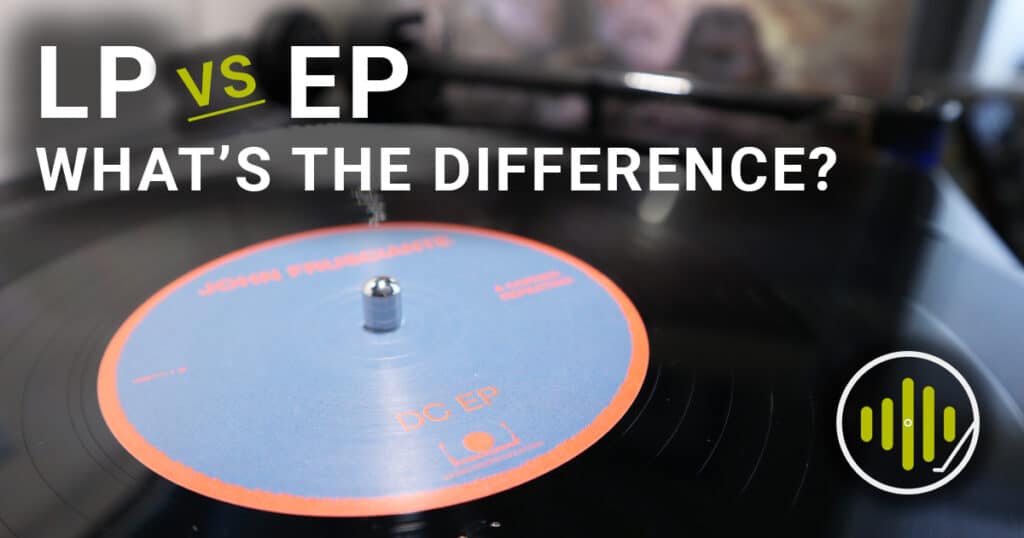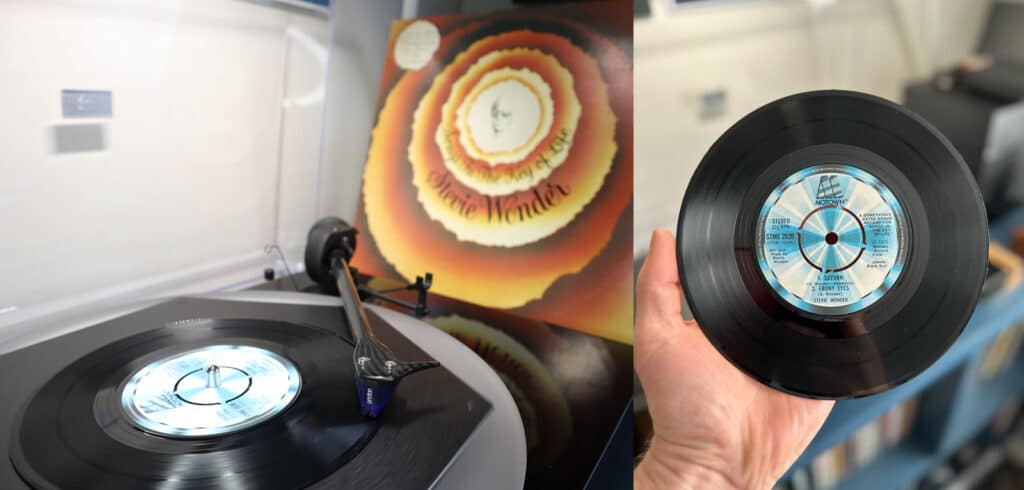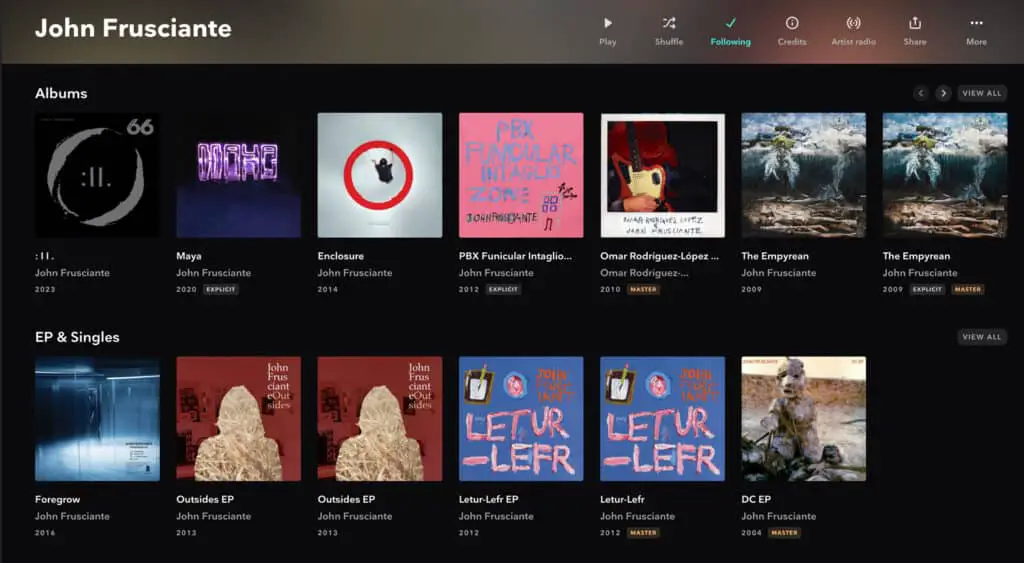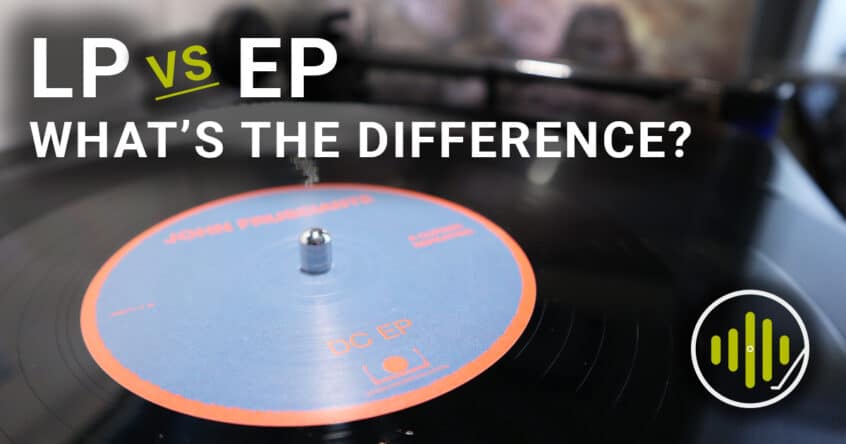The terms LP and EP are often used without thinking about their origin, and in our digital age, both are frequently misunderstood.
Like many acronyms in the music industry, their meaning has a historical background but continues to evolve.
Today, you’ll learn what an EP is, where the term comes from, how it differs from an LP, and what the term means today.

EP vs LP – The Short Answer:
Broadly speaking, an LP is a full-length album (on average, between 10 – 12 songs). An EP is a mini album, often containing between four to five songs.
To better understand why this is the case, you’ll now need to understand what each acronym stands for…
What is an LP?
The term “LP” stands for Long-Playing record. It was originally used to differentiate 33 and 1/3 RPM microgroove vinyl records (first introduced in 1948). LP records came as 12-inch or 10-inch discs.
Compared with traditional 78 RPM shellac records, these new records (made from polyvinyl chloride) had a much smaller groove size and slower running speed, which meant they could hold much more music per side. Hence the term long-playing (LP).
Older 78 RPM shellac records (abbreviated as 78s) could only hold around 5 minutes of music per side. LPs, on the other hand, can hold around 22 minutes per side.
The longer playing time facilitated the inclusion of full-length albums with multiple songs or tracks on each side of the record. As a result, the term “LP” became synonymous with albums of music on vinyl.
In a similar vein, the term “record” also became synonymous with the full-length album; so much so, that even through the introduction of the CD, and, later, digital downloads and streaming, artists and fans continued to refer to album releases as “records”.
LP is sometimes still used to signify a full album despite the release format, though not as much as the term “record”. A good example from the peak of CDs and the beginning of digital downloads is Eminem’s The Marshall Mathers LP.

Although the album was released on vinyl in the year 2000, the overwhelming majority of copies were purchased on CD.
Even though the term “LP” is usually associated with the vinyl format, It just goes to show how these terms stick in our collective psyche.
What is an EP? – LP vs EP
Closely associated with the term “LP” is “EP”, which stands for extended play. This causes some confusion as it does not mean longer than an LP.
Exact definitions vary, but in essence, an EP is longer than a single but shorter than a full-length album. EPs are effectively mini albums of around 4-5 songs.
Historically, they were released as album samplers (take a record like The Beatles’ The Beatles’ Hits), for example, but eventually, EPs featuring entirely new songs would become common.

EPs were usually 7-inch records but eventually became common across vinyl record sizes at 33 1/3 or 45 RPM.
Though EPs are often standalone releases in their own right, they can also be used to extend an LP release. A great example of this from my own record collection is Stevie Wonder’s Songs in the Key of Life — a double LP that also comes with a four-song bonus 7-Inch EP titled A Something’s Extra.
This 7-Inch single is cut at 33 1/3 RPM, which is different to the regular 45 RPM of 7-Inch singles.

Also worth noting when defining the EP is that while many singles have more than the standard A-Side and B-side, a single is released to promote one song (usually from a full album).
It is generally agreed that an EP is four or more songs of equal importance.
Popularity of EPs with Indie & Punk Bands
Through the late 70s and into the 80s, EPs became popular with punk and indie bands. In part, this is a natural move for up-and-coming artists as EPs were cheaper and easier to produce and made great promos or “samplers” of an artist’s work – particularly if they were seeking a record deal.
To this day, EPs remain a popular release format for indie or up-and-coming artists. Back in the early 2000’s my own band released an EP as a promo CD to give away at gigs. They’re easy to self-release, require less studio time, and they make great taster releases before moving toward a full album.
Can a Digital Release be Regarded as an EP?
“EP” as a term was coined during the heyday of vinyl records, but the term is still used today to describe mini album releases.
For example, Linkin Park and Jay-Z’s 2004 collaboration Collision Course, is regarded as an EP no matter what the release format.
A quick search of your favorite artist on a streaming platform like Tidal will show EPs and Singles listed separately from albums.
As an example, see a screenshot I took of John Frusciante’s Tidal page with several EPs dating from 2004 onward. The DC EP was a four-track mini album released as part of a six-month rally of six albums all released from July – December 2004.

In today’s challenging music industry environment, regular EP releases help bands or artists get in front of their audience at more regular intervals, as they don’t take as long to produce as a full album.
LP vs EP – Summing Up
Particularly with the re-birth of vinyl records over the last 15 years, the terms LP and EP still have meaning today.
Though they take their meaning from the vinyl format, they have become useful acronyms to differentiate between longer and shorter bodies of work.
In a digital sense, EP is used more than LP. For full-length albums, it’s more common to simply refer to them as an album or a “record”.




Even before the 1980’s, during the Disco years the term used was “Disco version, single or maxi single”. To this day I still have those versions. Even some of those versions the vinyl were produced in different color vinyl’s. Strawberry Letter 23, by the Brother’s Johnston, that vinyl was made in red to compliment the song. Extended Play was primarily used during the 1980’s.
Thanks for sharing 🙂
I’ve got 20 12″ EPs from the 80s; all extended songs from popular artists of the time. My favorite has to be ‘Everybody Wants to Rule the World’ by Tears for Fears. They really took advantage of the extra time with some cool guitar solos.
Nice! gotta love extra guitar solos